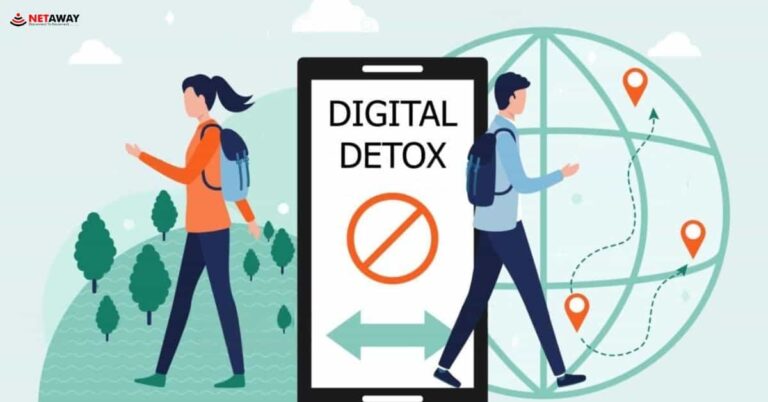
In today’s fast-paced digital world, we are bombarded with constant information, notifications, and social media. This can make us feel overwhelmed, stressed, and anxious, affecting our well-being. To address this, a digital detox is a great solution. It means taking a conscious break from technology for a short time. This break can bring many mental health benefits.
In this blog, we will explore simple steps you can take to start your digital detox journey. By stepping away from screens and devices, spending more time doing physical activities, connecting with loved ones, and practicing mindfulness, you can reduce stress, improve focus, and feel better overall.
The key is to be purposeful and mindful about your tech use. By doing so, you can regain control of your mental health and well-being in our tech-driven world.
Understanding the Impact of Technology on Mental Health
Before diving into the digital detox process, it’s essential to comprehend how technology affects our mental health. While technology has undoubtedly enriched our lives in many ways, excessive screen time can lead to adverse effects. Studies have linked prolonged device use to decreased attention span, disrupted sleep patterns, heightened stress levels, and even symptoms of depression and anxiety. Acknowledging the impact of technology is the first step toward making positive changes in our lives.
Step 1: Assess Your Digital Habits
Begin your digital detox by evaluating your current technology usage patterns. Take note of the time you spend on your smartphone, computer, or tablet throughout the day. Pay attention to which apps or websites are consuming the most of your time. This self-awareness will help you identify the areas that need improvement and create a personalized plan for your detox.
Step 2: Set Clear Goals for Your Detox
Outline your goals for the digital detox. Consider what you hope to achieve during this period. Whether it’s reducing stress, improving focus and productivity, or reconnecting with loved ones, having clear objectives will provide you with a sense of purpose and motivation.
Step 3: Create Boundaries
Establishing boundaries is crucial during a digital detox. Set specific time slots during the day for checking emails and using social media. Consider implementing a “no-screen” policy during meals or before bedtime. Designate certain areas in your home as “tech-free zones” to promote relaxation and connection with your surroundings.
Step 4: Notify Friends and Family
Inform your friends, family, and colleagues about your digital detox plan. Let them know that you may be less reachable through technology during this time. Encourage them to join you on this journey or support your efforts, so they understand and respect your boundaries.
Step 5: Find Offline Alternatives
Identify offline activities that bring you joy and fulfillment. Reconnect with hobbies you might have neglected due to excessive screen time. Engage in physical activities, spend time in nature, read books, or pursue creative endeavors. These activities will not only occupy your time but also contribute positively to your mental well-being.
Step 6: Practice Mindfulness
During your digital detox, embrace mindfulness practices such as meditation, deep breathing, or yoga. These activities can help you stay present and reduce stress and anxiety. Practicing mindfulness will enable you to manage digital cravings and foster a deeper connection with yourself.
Step 7: Set a Realistic Detox Duration
Determine the length of your digital detox that aligns with your goals and schedule. While a weekend detox can offer short-term benefits, consider extending it to a week or more for a more profound impact on your mental health. The key is to find a balance that works for you and fits into your lifestyle.
Step 8: Reflect and Learn
As you near the end of your digital detox, take time to reflect on your experience. Evaluate how the detox has affected your mental health, productivity, and overall well-being. Identify the challenges you faced and the strategies that helped you succeed. These reflections will guide you in maintaining a healthier digital-life balance going forward.
Conclusion
Incorporating a digital detox into your routine can significantly improve your mental health and overall quality of life. By setting clear goals, establishing boundaries, and engaging in meaningful offline activities, you can regain control over your technology usage and find a healthier balance. Remember to be patient with yourself during the process, and don’t hesitate to revisit the digital detox whenever you feel the need to recharge. Embrace the power of digital detox and unlock the many benefits it offers for your mind, body, and soul.
Q1. Does digital detox improve mental health?
Ans. A digital detox can improve mental health by reducing screen time and digital distractions, fostering better focus and emotional well-being.
Q2. What does digital detox do to the brain?
Ans. Digital detox helps the brain by reducing stress and improving focus, sleep, and mental clarity. It promotes healthier tech habits.
Q3. What is technology detox for mental health?
Ans. Technology detox for mental health refers to taking breaks from screens and devices to reduce stress and improve overall well-being.
Q4. How to do a digital detox for less stress and more focus?
Ans. Unplug from digital distractions for reduced stress and enhanced focus. Try a digital detox for a mindful break.
Q5. What are the negative effects of a digital detox?
Ans. Negative effects of digital detox may include anxiety, FOMO, boredom, and difficulty staying updated. Social disconnection can also occur temporarily.
